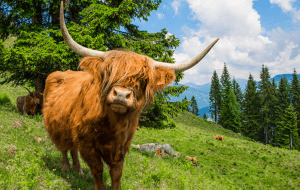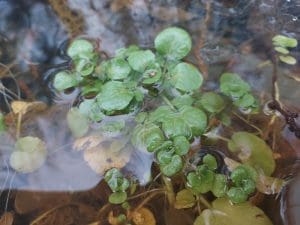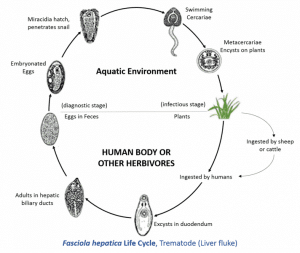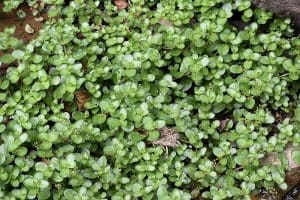We often wonder what is liver fluke? One of the hazards when foraging for any aquatic or semi aquatic plant for example Watercress (Nasturtium officinale) and Brooklime (Veronica beccabunga) is something called Liver Fluke.
It’s mentioned in a few of our ID guides so I thought that it would be worth discussing it in a little more detail.
Description of what is Liver fluke
Liver fluke (Fasciola hepatica), sometimes called Common fluke or Sheep liver fluke is a pathogenic flatworm parasite of ruminants, mainly sheep and cattle. It causes severe liver damage, especially in sheep, and can result in the sudden death of previously healthy animals.
Liver fluke is also a zoonotic disease which means it can infect people, although this is more of a problem in developing countries.
The adult flukes have a flat leaf-like body that measures 2-3 cm in length and are found in the bile ducts of the liver. They have an oral sucker and a ventral sucker, as well as spines on their surface, to help them lodge themselves in and attach to the tissue of their host.
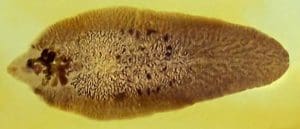
What’s the Life-cycle of Liver fluke?
Liver fluke has a complex two-stage life cycle.
Infective cysts are ingested during grazing and develop into juvenile fluke which then migrate from the gut through the liver to the bile ducts where they mature.
Adult fluke lay eggs (up to 25,00 per day) which are passed in dung where they develop and hatch before infecting an intermediate host.
In the UK this is the mud snail (Galba truncatula), which is found in wet muddy conditions and areas with poor drainage. The fluke develops in the snail, taking 6-8 weeks before the infective stages are shed and encyst on the pasture.
The life cycle of both parasite and snail is dependent on temperatures above 10 degrees centigrade and rainfall.
The incidence of fluke disease has been increasing over the past ten years. There are many reasons for this but recent wetter summers probably play a role, providing ideal conditions for the snails and the parasite to reproduce.
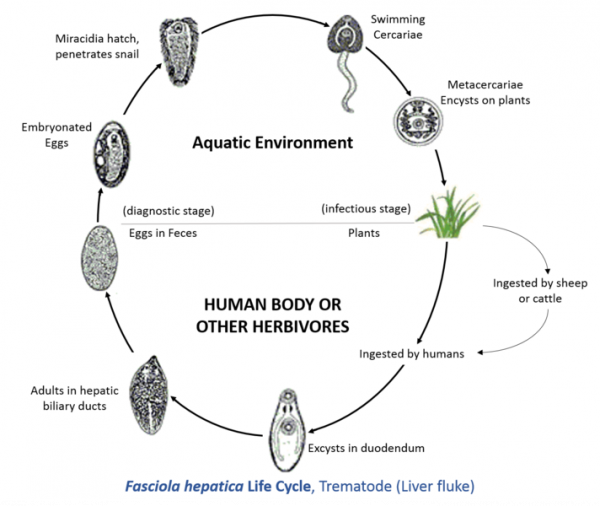
What are the symptoms of Liver fluke?
A disease due to liver fluke is known as fasciolosis.
Human symptoms vary depending on whether the disease is chronic or acute.
Acute Phase
During the acute phase, the immature worms begin penetrating the gut, causing symptoms of fever, nausea, swollen liver, skin rashes, and extreme abdominal pain.
Chronic Phase
The chronic phase occurs when the worms mature in the bile duct, and can cause symptoms of intermittent pain, jaundice, and anemia.
Are commercial Crops safe?
You might be thinking how safe is the Watercress that I get from the shop?
Well, no need to worry, farmed watercress is fed by pure water from underground aquifers that is constantly tested to ensure purity, so there is no risk.
How to avoid the risk of Liver flake?
The first thing to say about fluke is that it is completely destroyed by cooking. It is only a risk if you are intending to eat these plants raw. Washing and thoroughly cooking the ingredient would make them completely safe.
If you are planning on including them in a salad for example some authorities suggest washing or soaking water-grown vegetables in a 6% vinegar solution for 10-15 minutes to destroy any pathogens.
Also more common sense things, fluke cannot climb. They encyst on plants near the water level, so as long as the water level has not fallen significantly since they encysted and the growth is young and vigorous, the fresh tips of the plant should be quite safe to eat. Also avoid watercourses where animals such as cattle and sheep are present.
Some say that the risk of fluke has been exaggerated and I’d be lying if I said that I hadn’t eaten plenty of raw Wild Watercress in the past but I’ll let you decide.
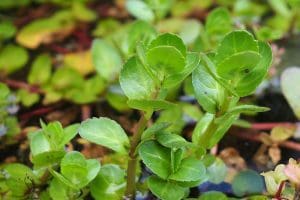
References:
https://patient.info/doctor/fasciola-hepatica
https://gallowaywildfoods.com/watercress-edibility-distribution-and-identification/



